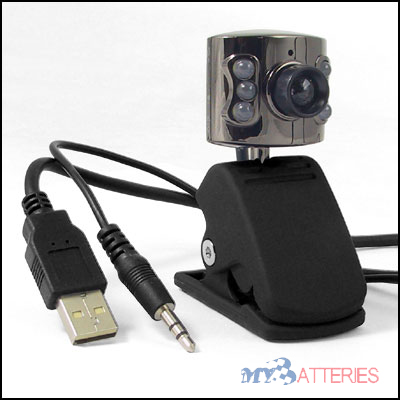|
|---|
| Resolution: | 14.20 Megapixels |
| Kit Lens: | 3.00x zoom
18-55mm
(27-83mm eq.) |
| Viewfinder: | LCD |
| LCD Size: | 3.0 inch |
| ISO: | 200-12800 |
| Shutter: | 30-1/4000 |
| Max Aperture: | 3.5 |
| Dimensions: | 4.6 x 2.5 x 1.3 in.
(117 x 63 x 33 mm) |
| Weight: | 18.0 oz (511 g)
includes batteries, kit lens |
| MSRP: | $600 |
| Availability: | 07/2010 |
14.20
Megapixels | Sony E-mount | 3.0 inch
LCD |
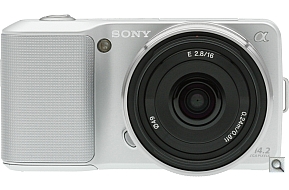 |
Sony Alpha NEX-3 Overview
Reviewed by Dave Etchells, Shawn Barnett, Zig Weidelich, and Mike Tomkins
Hands-on Preview Posted: 05/11/2010
Updated to Full Review: 07/09/2010
As the fourth major manufacturer to enter the market for small, mirrorless digital cameras with interchangeable lenses, Sony had to make a big impression. We think they'll do just that with the new Sony NEX-5 and NEX-3, two cameras they're calling "alpha compact interchangeable lens digital cameras."
The promise of mirrorless digital cameras has been high image quality without all the bulk, and the photographic versatility of interchangeable lenses. The Sony NEX-5 delivers that better than any model so far, and does it with style and a sturdy build.
Car Leasing
There are so many interesting innovations in the Sony NEX-5 and NEX-3, that it's difficult to know where to start. Easily the biggest news, though, is that the Sony NEX series is the first interchangeable lens digital camera system designed to tackle continuous autofocus and exposure adjustment while recording video, where all the components, bodies and lenses, support the feature. (Panasonic's GH1 was the first to take on this challenge, but only Panasonic's HD lenses support these advanced features, not every Micro Four Thirds lens.) Video is indeed the one major area, aside from size, where the two new cameras differ: The NEX-5 supports 1080i AVCHD video recording, while the NEX-3 is limited to 720p video capture.
A 14-megapixel Exmor APS HD CMOS sensor is responsible for the high quality we found in the images from both cameras, and a new Bionz processor is also hard at work in the two cameras.
Several hot features were brought over from recent Alphas and Cyber-shot digital cameras, including Sweep Panorama, Auto High-Dynamic Range shooting, Handheld Twilight, and Anti-motion-blur modes, each of which strategically combine and align several images into one seamless one. It's pretty impressive stuff. As if that weren't enough, Sony's also announcing an upcoming upgrade (even before the cameras ship!) that will enable a special 3D Sweep Panorama mode that will work with several as-yet unannounced Bravia TV sets coming in July 2010.
Both the Sony NEX-5 and NEX-3 sport a wide, 3-inch LCD with 921,000-dot resolution. The surprise is that the super-slim LCD tilts up 80 degrees and down 45 degrees for easy viewing. With TruBlack technology borrowed from Sony's picture frames, shooting in or out of doors is a pretty good experience.
Though by name the new cameras are Alphas, they no longer use the Alpha mount; instead Sony has christened a new E-mount, for which two lenses will ship right away, both as kit lenses. The first is a fairly standard 18-55mm f/3.5-6.3 lens with Optical SteadyShot, and the second is a 16mm f/2.8 pancake prime lens. Both have a beautiful aluminum barrel in brushed gunmetal gray.
An adapter is available for mounting Alpha lenses, but autofocus will be disabled with the NEX cameras. Two converters will also ship for use with the 16mm lens: an Ultra Wide Converter with a 12mm equivalent view, and a Fisheye Converter.
Finally, an 18-200mm f/3.5-6.3 OSS lens is planned for shipment some time this year.
Both the Sony NEX-5 and NEX-3 accept both Memory Stick Pro Duo/Pro-HG Duo/Pro-HG HX Duo and SD, SDHC, and SDXC media.
The NEX-5A will ship in July with the 16mm lens for US$650, while the NEX-5K with the 18-55mm lens will sell for US$700. NEX-3A cameras with the 16mm lens will sell for US$550, while the NEX-3K cameras with the 18-55mm will sell for US$650.
Sony NEX-3 User Report
by Shawn Barnett, with Mike Tomkins
While "smaller and more aggressive" was the tactic with the NEX-5, the Sony NEX-3 takes a more conservative approach, taking on a size not much smaller than an Olympus E-P1. Both new Sony cameras evoke the memory of the Sony F505 through the F717, unusual looking cameras produced from 2000 to 2002, with a small grip and large, protruding lenses. Unlike the competition in this space, there's next to no camera body left of the lens, with all the body appearing either directly behind or to the right of the grip (as viewed from behind).
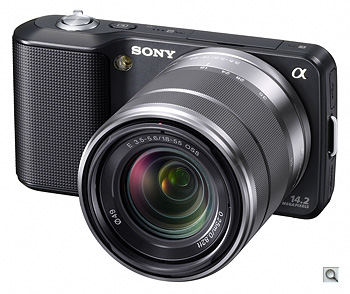 Look and feel
Look and feel. Unlike the rest of the SLD (single-lens, direct-view) digital cameras, the Sony NEX-3 doesn't try at all to look like an SLR or rangefinder. Instead it looks more like a midsize digital camera with a big lens grafted on. Bordering on the absurd, the NEX-3 manages to pull off this seeming overemphasis on optics if only because of the lens's shiny aluminum barrel, whose efficient shape speaks of precision. After several years of relative sameness among digital camera designs, it's refreshing to see something bold. Least inspired of the colors among the Sony NEX-3 line is the silver body we received, which makes it harder to get as excited about this camera's particularly understated finish, so I've used Sony's black body images for the first two shots. The Alpha NEX-3 is also available in red.
Smallest among the new line's competition, the Sony NEX-3 is also light. Its plastic body weighs just 10.5 ounces (0.69 pound, 297g) with battery and card, and adding the lens raises the weight to 18 ounces (1.1 pounds, 511g). By comparison, the Panasonic G2 weighs 21.8 ounces (1.36 pounds, 618g); the Olympus E-P2 weighs 19 ounces (1.2 pounds, 539g); and the Samsung NX10 weighs 21.5 ounces (1.3 pounds, 610g) each with kit lens, battery, and card.

Much like sportscars show their command of the road by contrasting their low profile bodies with large, fully exposed wheels, the Sony NEX-3 design shows its command of light by contrasting its small digital camera body with a large, burnished gunmetal lens (the 18-55mm is shown here). Lower left of the lens in this shot is the lens release button, and upper left is the AF-assist and self-timer lamp. Unlike the Sony NEX-5, there is no infrared remote control port on the NEX-3.
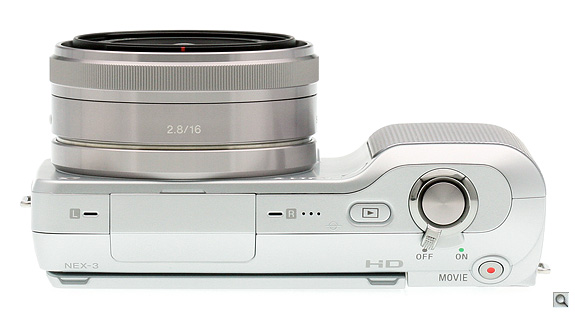
From the top you see the stereo microphones, rather obviously marked L and R, and the three holes for the speaker. Between these two mics is the accessory flap, which you lift up and back, pivoting on its rubber hinge, to access the small accessory port. So far, the port accepts the included accessory flash and the optional accessory microphone; for now we haven't heard of any plans for an accessory EVF, though Sony plans to release an optical viewfinder accessory with a 16mm field of view.

Thickness. While the Sony NEX-3's lens mount makes the Sony 16mm lens look thicker, it's really about the same thickness as the Olympus 17mm M.Zuiko. Click the image for a larger view.
The large rear-accessed power switch rings the shutter button. Note the wide, thinner grip. It's easily the least comfortable aspect of the Sony NEX-3, because it's too wide, and the grip angle is too shallow, giving the fingers less to grip, while the Sony NEX-5's grip is much thicker front to back, with a deeper angle. The Playback button is also on top, which is a bit of a nuisance, since it's one of the things you want to quickly find and activate while you're looking at the LCD.
Here also is the first evidence of the tilting LCD screen, just left of the Movie Record button.
The 16mm f/2.8 lens also has an aluminum barrel, and looks larger than it is, thanks to the metal mount, which is several millimeters thick. The lens is actually about as thick as the Olympus 17mm f/2.8 M.Zuiko pancake lens. The 16mm lens will also accept the Ultra Wide Converter lens (VCL-ECU1) and the Fisheye Converter (VCL-ECF1), which mount on the bayonet located on the inset plastic barrel that holds the actual lens elements.
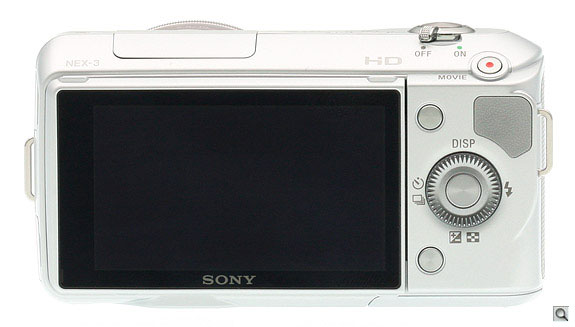
Note the position of the two camera strap lugs. The Sony NEX cameras are designed to hang with the lens pointing down, just like their spiritual predecessors (the F505-F717 mentioned earlier). This has several advantages, one being that the screen is less likely to be scratched by shirt buttons, and the small camera body won't pitch forward at different angles depending on what lens you have mounted. Sony knows that the lenses will usually tip the camera forward, especially on a camera whose body is so light, so why not just hang the lens downward in the first place? What I discovered when I attached the strap was that several of the camera's design elements that seem awkward at first suddenly make perfect sense.
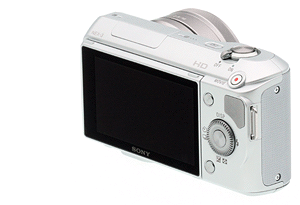 Tilting LCD
Tilting LCD. The 3-inch LCD tilts up 90 degrees and down about 45 degrees, and has a 921,000-dot resolution. The display also uses Sony's Clear Photo LCD Plus and Tru Black technology from Sony's line of digital picture frames.
With the strap attached, the LCD is always facing up, ready for chimping. Wrap your fingers around the Sony NEX-3's grip and bring your thumb around and up to the strap, and your thumb easily reaches the power switch. Draw your thumb back to use the Control wheel and soft keys. The Control wheel is very well designed, with a high edge around the perimeter with fairly sharp cuts for a good grip. Rather than fill the small space with expensive buttons, Sony has designed a new interface that's context-sensitive. The menu's responsiveness is very quick, with snappy clicks to accompany wheel motion and onscreen action. It's sometimes confusing, but always responsive. More on this later. We did notice that using the Control wheel to make frequent adjustments can wear on your thumb after only a short time, so beware.
Inside the Sony NEX-3

APS-C with digicam features. The NEX-3 uses an all-new Sony Exmor CMOS sensor that combines the large, low-noise pixels of APS-C format chips with advanced high-speed features previously found only in Sony's Exmor-R digicam sensors. The photo above shows the sensor from the NEX-3 next to an Exmor-R sensor of the sort used in Sony's X-series digicams. (TX7, HX5v, etc.)
. The Sony NEX-3 and NEX-5 have the company's third generation Exmor sensor. It is an APS-C sized HD-CMOS sensor that Sony says is 60% larger than a Four Thirds sensor, and 13 times larger than a typical video camera sensor, so they expect performance gains in both areas.
Dust. The Sony NEX cameras have a dust abatement and removal system, where they've included a charge-protection coating on the low-pass filter, and they also vibrate the low pass filter to shake dust free.
Processor. Sony doesn't say much about the new Bionz processor beyond that it's the third generation of the chip. Looking at the images, it could be a big part of what's improved their image quality so much.
Autofocus and metering. The Sony NEX-3 uses contrast-detect autofocus only. It has two autofocus modes AF-S for single and AF-C for continuous focusing. There are three autofocus area modes, including Center, Multi, and Flexible Area modes. You can also choose full Autofocus, DMF, which allows you to adjust focus after the autofocus operation, and Manual Focus. Focus is fast and fairly accurate. See the Shooter's Report or Performance tab for more.
The Sony NEX-3 has the option of Spot, Center-weighted, and Multi-area metering.
Optics. Sony's new lenses are designed to respond more quickly than conventional SLR lenses can, with the express purpose of enabling autofocus while shooting video. Most SLRs either disable autofocus while capturing video, or else they essentially ruin the bit of the video where you're focusing because of the lens motor noise and the excessive focus and exposure changes required.
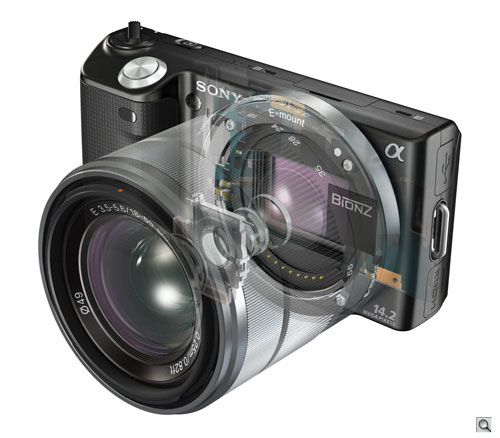 |
Sony developed an all-new lens system for the new NEX line (shown here on an NEX-5, with a shorter flange distance (back-focus distance) to yield more compact lenses, and lenses with faster, more precise focus drive to meet the demands of live contrast-detect autofocus during video recording. The lens irises are also driven by stepper motors to provide continuous aperture adjustment to prevent sudden jumps in brightness as the aperture is adjusted while video is being recorded. |
Sony says the new E-Mount lenses have silent focus and silent, continuous aperture control. See our
Optics tab for a more thorough writeup of Sony's new approach, as well as our completed test results for both kit lenses.
White balance options include Auto, Daylight, Shade, Cloudy, Incandescent, Fluorescent, Flash, Color Temperature/Filter, and Custom.
Menus. Sony's introducing a whole new menu system on the NEX series cameras, one that looks and sounds quite snappy as you navigate, but our pre-release cameras had a few problems that served as the only real negative points in our experience with the NEX-5 and NEX-3. See the Shooter's Report for more on that. The general interface is pretty good, if you stick to the basic controls.
Special features. The Sony NEX-3 comes with quite a few special features borrowed from the Cyber-shot line, the most interesting of those being the Sweep panorama feature.
 |
First seen on Sony's TX1 and WX1 digicams a year ago, the high-speed ability of the NEX-3's advanced Exmor CMOS image sensor and the power of Sony's Bionz processor lets you capture in-camera panoramas by simply holding down the shutter button and "sweeping" the camera across in a short arc. The result can be a panorama up to 12,416 pixels wide, covering a horizontal angle of 149 - 226 degrees. Or, sweep the camera vertically, for a narrower/thicker panorama up to 5,536 pixels wide, covering a vertical angle of 106 - 151 degrees. Sony's high-speed technologies take SLD shooting into a whole new dimension. (And sometime in July of 2010, it'll literally take you to a new dimension, when a firmware update will let you create panoramas in 3D, for display on Sony's 3D HDTV sets.) |
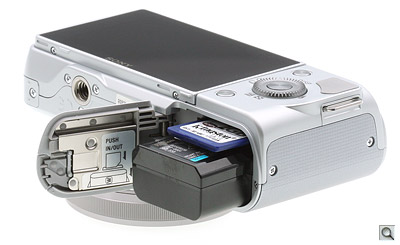 Storage and battery
Storage and battery. The Sony NEX-3 is compatible with two memory card standards, each with various permutations. The first is Memory Stick Pro Duo/Pro-HG Duo/Pro-HG HX Duo, and like Olympus did with the Pens last year, Sony now also supports SD, SDHC, and SDXC media in the same slot.The Sony NEX-3 uses a 7.2V 1080mAh lithium-ion battery with part number NP-FW50. Tested to the CIPA standard, the Sony NEX-3 is expected to get about 330 shots per charge. Expected Battery life is shortened somewhat because while the camera is on and in Record mode, the Sony NEX-3 will continue to seek focus whether you're in continuous or single focus mode.
Sony NEX-3 Comparisons
Size is a big advantage to SLDs, and the Sony NEX-3, while not as small as the NEX-5, is still smaller than most. But first, how much larger is it than the NEX-5?
Sony NEX-3 vs Sony NEX-5
 |
With the silver against the black, it's hard to tell how much smaller the NEX-5 is than the NEX-3. In the hand it's more noticeable than it seems here, but they are indeed close, meaning that the NEX-3 is still pretty small. |
 |
This view gives a little better idea of the size difference, as lens pops up above the body more on the NEX-5. |
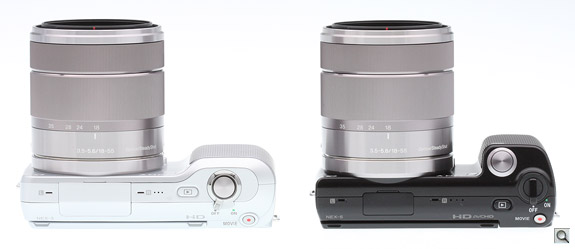 |
From this angle it's mostly body thickness and grip width. The mounting flange also protrudes more on the NEX5, keeping the focal length the same despite the thinner body of the NEX5. |
 Nikon digital camera batteries
Nikon digital camera batteries


























